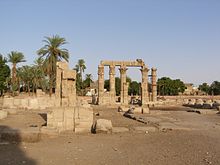al-Madamud
Al-Madamud (also Medamud, Médamoud, Medamut, Medamot, Arabic المدامود al-Madāmūd , completeنجع المدامود Nadsch 'al-Madamud , DMG Naǧʿ al-Madāmūd ' Hamlet al-Madāmūd ', ancient Egyptian: Madu , Coptic: ⲘⲈⲦⲈⲘⲞⲨⲦ, Metemout ) is a still inhabited village in Upper Egypt ( Egypt ) north of Karnak or about 8 km northeast of Luxor . To the west of the village is the Month Temple, an archaeological site.
Significance and function of the place in antiquity
The ancient Egyptian place Madu ( M3dw ) has been documented as the site of the Month temple since the end of the Old Kingdom or the 1st Intermediate Period . The place name has been preserved through Coptic to this day. Obviously the place had no other function. The local temple is one of the oldest archaeologically proven temples in Egypt.
Revered deities
The local temple was dedicated to the gods triad of Madu, these are the war god Month, mostly depicted in the shape of a bull in the late period , his consort Rat-taui (" Council of the Two Lands"), a female sun goddess, and her son Hor-pa-Re- pa-chered (" Horus-Re, the child "). Before the introduction of Amun as the main god in the Theban Gau , Month was the main god of this Gau. In the Theban area the Month temples in Karnak and in at-Tod are still dedicated to this god.
In Ptolemaic (Greek) times , the wind and fertility god Amun is worshiped here to the same extent, but his worship in this temple began in the New Kingdom.
Building history
A first simple temple was located in the east below the current temple. It dates to the end of the Old Kingdom or the First Intermediate Period, but before the 11th Dynasty . From the north, two pylons , one behind the other, led to a double cave sanctuary, the underground chambers of which were marked on the surface with mounds of earth. These mounds of earth certainly had the function of primeval mounds . With the rise in the water table since the Aswan High Dam was built in 1970, this early temple was lost.
Sesostris III. ( 12th Dynasty , Middle Kingdom ) had this first temple built over with its own temple. The approximately 60 × 100 m large, north-south oriented temple was built from adobe bricks . Only the doorways and pillars including the architrave were made of limestone . The entrance to the temple was in the north. Two gates could be reconstructed from the fragments found. The Sedfest portal, which is dedicated to the coronation anniversary of Sesostris III. is now on the ground floor in the Egyptian Museum of Cairo , the second in the open-air museum in the Temple of Karnak.
In the 13th dynasty , the temple was expanded and further decorated, especially under Sobekhotep II . In the New Kingdom Thutmose III. build his own 21 × 32 m temple in the west of the temple from the Middle Kingdom. It was oriented in a west-east direction and consisted of a pillared hall , an offering table hall and a barque sanctuary . Strictly speaking, the temple complex is already a double temple at this time.
In Greco-Roman times the temple was demolished, replaced by a new building and greatly expanded. Ptolemy VIII Euergetes II (around 180-116 BC) had a pronaos added to the west of the temple, of which five columns and architraves still stand upright today. The Roman Emperor Antoninus Pius (86–161) had the temple extended by a further, western courtyard with a double row of columns - the temple was now about 75 m long and 42 m wide. Emperor Tiberius Caesar Augustus (42 BC - 37 AD) had a gate built for the surrounding wall at the end of Sphinx avenue .
To the west of the temple there is a 200 m long avenue of sphinxes that led to the quay.
At the end of the 4th century a Coptic church was built on the temple area .
Research history
The temple was explored in 1925–1932 by the French Egyptologists Fernand Bisson de la Roque , Alexandre Varille and Clément Robichon on behalf of the Musée de Louvre in Paris . Some of the finds are now exhibited in the Louvre and the Museum of Fine Arts in Lyon .
literature
- Dieter Arnold : The temples of Egypt: apartments of gods, places of worship, monuments. Artemis & Winkler, Zurich 1992, ISBN 3-7608-1073-X , pp. 160-163.
- Fernand Bisson de la Roque: Report on the fouilles de Médamoud. In: Fouilles de l'Institut Français d'Archéologie Orientale du Caire. Volumes 3–9, Imprimerie de l'Institut français d'archéologie orientale, Le Caire 1926–1932.
- Hans Bonnet: Medamud. In: Lexicon of Egyptian Religious History. Nikol, Hamburg 2000, ISBN 3-937872-08-6 , pp. 444f.
- Wolfgang Helck , Eberhard Otto : Medamud. In: Small Lexicon of Egyptology. Harrassowitz, Wiesbaden 1999, ISBN 3-447-04027-0 , pp. 180f.
- Jean Revez: Medamud. In: Kathryn A. Bard (Ed.): Encyclopedia of the Archeology of Ancient Egypt. Routledge, London 1999, ISBN 0-415-18589-0 , pp. 475-81.
- Clément Robichon: Description of the sommaire du temple primitif de Médamoud. Imprimerie de l'Institut français d'archéologie orientale, Le Caire 1940.
- Dominique Valbelle: La porte de Tibère à Médamoud. L'histoire d'une publication. In: Bulletin de la Société Française d'Égyptologie. (BSFE) Volume 81, Paris 1978, pp. 18-26.
Web links
Coordinates: 25 ° 44 ′ 0 ″ N , 32 ° 42 ′ 45 ″ E

